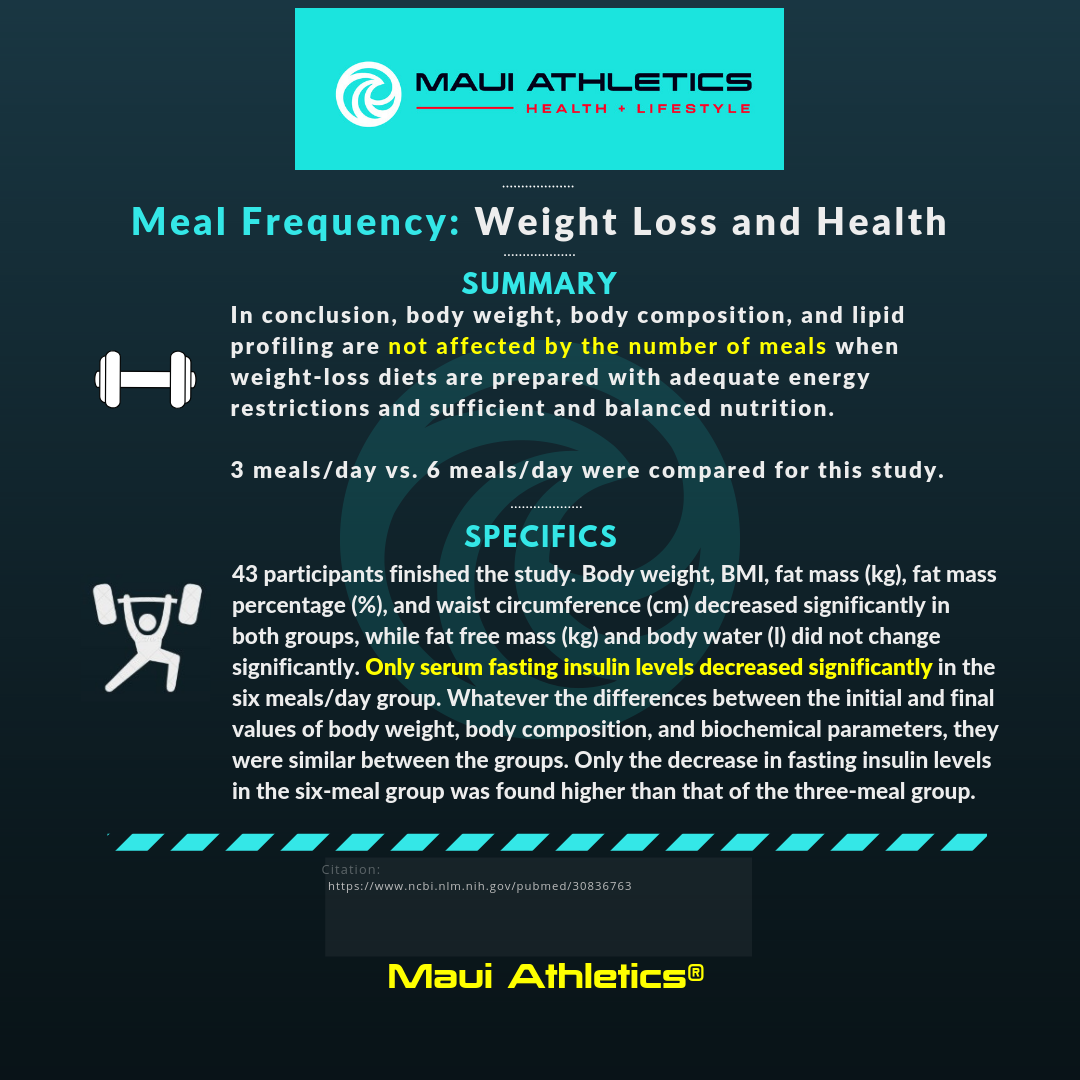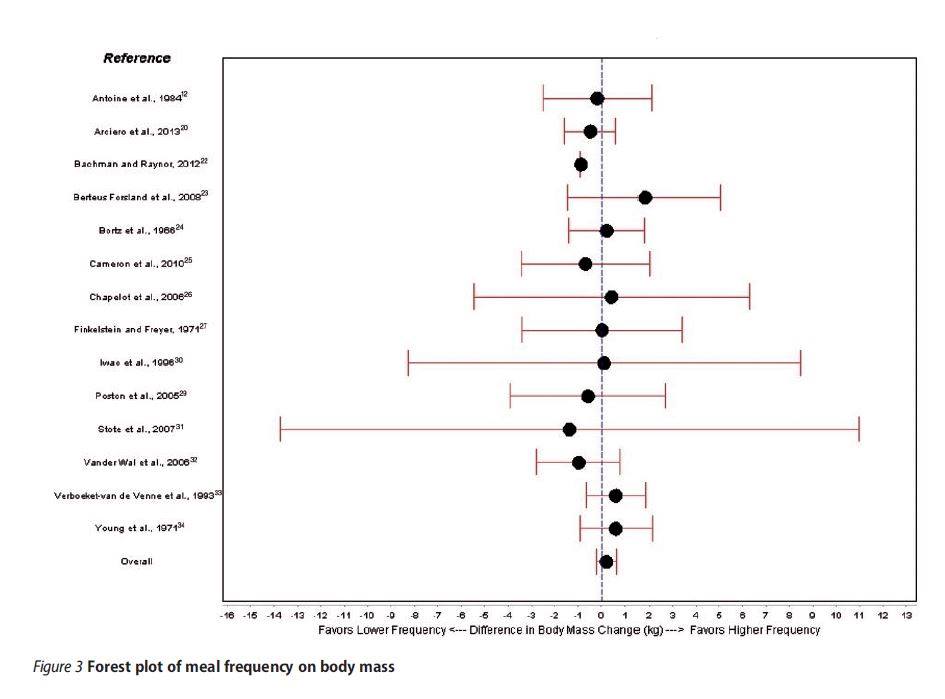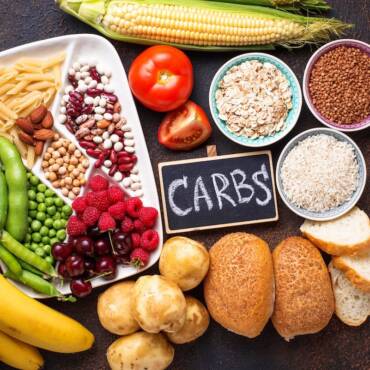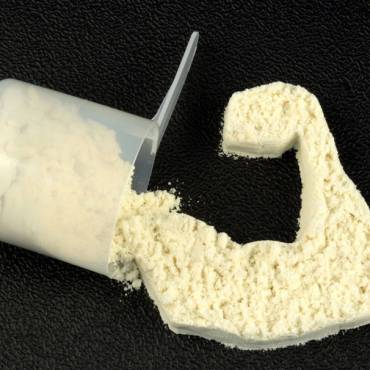Meal Frequency
Overview
Meal Frequency has been a hotly debated topic over the years, both for the applications of fat loss and muscle gain. Many have heard the old adage of “stoking the metabolic fire” referring to the theory that eating multiple meals a day actually increases fat burn through the Thermic Effect of Food. When discussing muscle gain, many have suggested consuming multiple meals per day because the body can “only absorb so much protein at one time”. Therefore, the idea goes, that having many smaller protein-containing meals would maximize utilization of protein for muscle growth potential. So what does the research say? At the moment, there are some gaps in the evidence, but we can make informed predictions based on current knowledge. Feel free to skip to the Practical section if you prefer the take-home message to the nerd-speak.
First, let’s discuss free form amino acid and whole protein intake with regards to body composition. Understand that short-term changes in acute muscle protein synthesis (MPS) do not necessarily predict changes in body composition in the long-term.Mitchell 2014, PMID: 24586775 Therefore, longer term elevations of MPS are a better indicator of positive change in body composition. Next, let’s look at the potential for muscle growth and the body’s potential to utilize protein and amino acids. Although there is no limit to the amount of nutrients that can be absorbed from the gut into circulation, there is potential for competitive absorption at the level of the intestinal enterocytes.Gropper & Groff 2009 The amino acids in the highest concentrations are preferentially absorbed, which can become problematic when supplementing with exogenous free form amino acids such as BCAA products. Those in lower concentrations may end up in short supply in circulation. You can read the full story in our BCAA Research article.
The previous example looks at amino acid ingestion in isolation. When looking at whole protein ingestion, research such as Areta et al (2013) suggests that a ceiling of ~20g of protein at one time provides maximum benefit. This can be misleading. The problem here is that this study, and those similar, look at whey protein supplementation in isolation (without the presence of other food or protein sources). Whey is a fast-acting protein that is digested at a rate of around 10g/hour.Bilsborough & Mann 2006 This fast-absorption can lead to a lower net protein accretion (when compared to slower-absorbing protein sources) due to greater amino acid oxidation.Dangin et al 2002 Studies such as Areta et al (2013) do not take into account extended digestion rates that occur in a normal mixed meal scenario (particularly due to added fats and carbohydrates), varying compositions of protein sources (egg, for instance, is digested at 1/3 the rate of whey)Bilsborough & Mann 2006, age, lean body mass, and training status…all of which can alter protein utilization.
The slowing of digestion in a mixed meal scenario would mean that much larger servings of protein could be practically put to use. Your body will simply have more time to utilize the amino acids since the protein will be broken down more slowly; which also leads to an increased anabolic response at the whole-body level.PMID: 25352437, 28318687 Although there exists an upper limit at which protein will be oxidized for energy rather than used for muscle building, protein intakes can likely be well above 20g in one sitting in a whole meal. Knowing this, we can be confident that larger protein amounts can be eaten in a mixed-meal scenario without necessitating the spread over a large number of meals per day.
Practical
In a calorie deficit, such as is utilized when trying to lose fat, it has been shown that number of meals does not have significant bearing on body composition changes.Schoenfeld 2015, Bellisle 1997, Hutchison 2016 Fewer meals may be preferred by some for appetite suppression effects and may also support lower blood glucose levels, on average.Munsters 2012, Holmstrup 2010, Jakubowicz 2019 Additionally, body weight, body composition, and lipid profiling are not affected by the number of meals when weight-loss diets are prepared with adequate energy restrictions and sufficient and balanced nutrition.Yildiran & Mercanligil 2019 Given this (and keeping overall nutrient absorption in mind), I would recommend 2+ meals per day in a hypocaloric environment when fat loss is your goal.
In a calorie surplus, such as is utilized when trying to gain muscle or increase strength, it is important to understand that the anabolic effect of a protein-rich meal lasts approximately 5-6 hoursLayman 2004 and eating more frequently than every 2-3 hours does not appear to improve lean muscle mass gain.Arnal 1999, Arnal 2000, Stote 2007 It has also been suggested that a bolus of at least 30g of high quality protein may be needed to maximally stimulate muscle protein synthesis.Symons et al 2009 Given that we wish to maximally increase MPS for longer periods to yield the best return, I recommend a diet structure of a minimum of 3-4 meals, spread throughout the day, containing 30g+ protein each meal. Once this is accounted for, the remaining protein in one’s diet can be eaten per the individual’s preference.
Further Research
Fat Loss

Body weight, body composition, and lipid profiling are not affected by the number of meals when weight-loss diets are prepared with adequate energy restrictions and sufficient and balanced nutrition. (it is worth noting that some other studies have suggested benefits to insulin and triglycerides/cholesterol with increased meal frequency)

Body weight, body composition, and lipid profiling are not affected by the number of meals when weight-loss diets are prepared with adequate energy restrictions and sufficient and balanced nutrition. (it is worth noting that some other studies have suggested benefits to insulin and triglycerides/cholesterol with increased meal frequency)
This large scale meta-analysis (covering 15 studies that met inclusion criteria) shows that meal frequency does not significantly affect total body weight change.
Sensitivity analysis showed that removal of a single study (Iwao et al) completely eliminated the significant effect of meal frequency on changes in body composition. In an energy deficit condition where fat loss is the goal, follow a dietary structure that allows for preference, enhances adherence, and supports athletic needs as best as possible.
https://www.ncbi.nlm.nih.gov/m/pubmed/26024494
Despite what is often claimed, consuming small, frequent meals doesn’t “stoke your metabolism” to enhance weight loss. Pictured above is a forest plot of the meta-analysis from Schoenfeld et al 2015 – note that the solid circles reside almost equally on either side of the ‘zero line’ that separates greater vs lesser meal frequencies. This indicates similar weight loss regardless of how often you eat (provided calories are equated). On the other hand, a case can be made that a minimum of 3-4 daily meals are needed to maximize muscle building since the anabolic effects of a protein-rich meal last approximately 5 hours.
Muscle Growth + Strength
“We have proposed that the branched-chain amino acid leucine is a key to the metabolic advantage of a higher protein diet because of its unique roles in regulation of muscle protein synthesis, insulin signaling and glucose re-cycling via alanine. These metabolic actions of leucine require plasma and intracellular concentrations to increase above minimum levels maintained by current dietary guidelines and dietary practices in the U.S. Initial findings support use of dietary at levels above 1.5 g/kg . d during weight loss. Further, our research suggests that increased use of high quality protein at breakfast maybe important for the metabolic advantage of a higher protein diet.”
Muscle Growth + Strength
“We have proposed that the branched-chain amino acid leucine is a key to the metabolic advantage of a higher protein diet because of its unique roles in regulation of muscle protein synthesis, insulin signaling and glucose re-cycling via alanine. These metabolic actions of leucine require plasma and intracellular concentrations to increase above minimum levels maintained by current dietary guidelines and dietary practices in the U.S. Initial findings support use of dietary at levels above 1.5 g/kg . d during weight loss. Further, our research suggests that increased use of high quality protein at breakfast maybe important for the metabolic advantage of a higher protein diet.”
“We have proposed that the branched-chain amino acid leucine is a key to the metabolic advantage of a higher protein diet because of its unique roles in regulation of muscle protein synthesis, insulin signaling and glucose re-cycling via alanine. These metabolic actions of leucine require plasma and intracellular concentrations to increase above minimum levels maintained by current dietary guidelines and dietary practices in the U.S. Initial findings support use of dietary at levels above 1.5 g/kg . d during weight loss. Further, our research suggests that increased use of high quality protein at breakfast maybe important for the metabolic advantage of a higher protein diet.”
https://www.ncbi.nlm.nih.gov/pubmed/15640518
When discussing the amount of protein that can be consumed at one time to maximize muscle protein synthesis, it’s important to understand that studies on the topic are conducted in a sterile setting with subjects consuming only a bolus of whey protein. While this provides good insight into the condition studied, the practical relevance of results must be taken in context to real world settings where people consume mixed meals. Intake of fats and carbs along with protein slows down digestion. Moreover, whey is a “fast-acting” protein while other proteins are assimilated more slowly. Thus, the consumption of larger mixed protein meals won’t necessarily be “wasted” as the additional protein can potentially be utilized for anabolic processes over the time of digestion.
https://www.ncbi.nlm.nih.gov/pubmed/27511985
“we conclude that to maximize anabolism one should consume protein at a target intake of 0.4 g/kg/meal across a minimum of four meals in order to reach a minimum of 1.6 g/kg/day. Using the upper daily intake of 2.2 g/kg/day reported in the literature spread out over the same four meals would necessitate a maximum of 0.55 g/kg/meal.”
doi: 10.1186/s12970-018-0215-1










